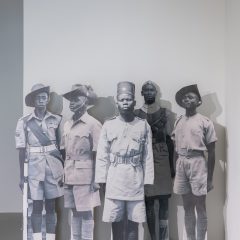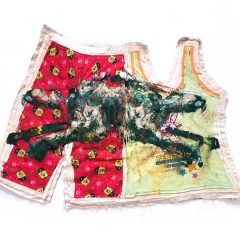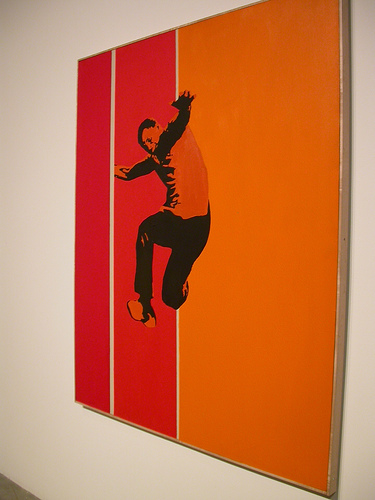
Rosalyn Drexler, Race for Time, 1964
Here’s a few photos from the opening Thursday night of Rosalyn Drexler‘s show “I am the Beautiful Stranger: Paintings of the ’60s” at PaceWildenstein. We at Artblog have been beating the drum for this artist since we saw her amazing show in 2004 at Rosenwald-Wolf Gallery.
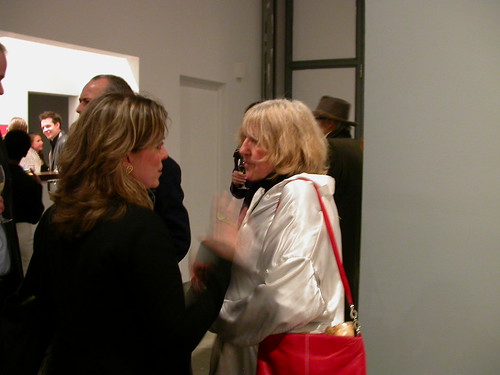
Rosalyn Drexler, right, dressed like her paintings, in 3 basic colors: white, black and red.
We asked the artist, who we believe may be 80 years old, how she got this show at Pace. She told us that she emailed Arnie (Glimcher, head of the gallery), with whom she’d showed in the distant past. Arnie and Rosalyn went back and forth about the show for two years and finally the time was right and so the show is up. Happily, as Libby told you in her post about Jeff Wall, many of the paintings are on reserve which means interested buyers!
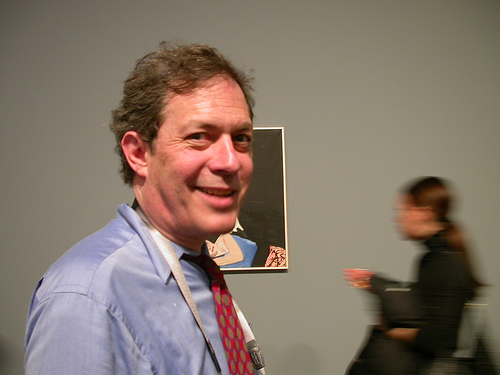
Sid Sachs, Rosenwald-Wolf Gallery Curator, who brought Rosalyn Drexler to our attention with a wonderful retrospective show at his gallery in 2004.
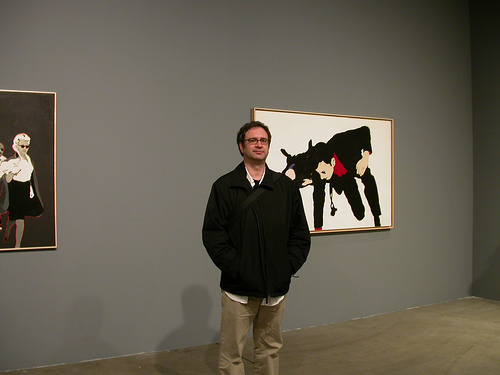
Brent Burket, artblog pal and Heart As Arena blogger, looking nicely coordinated with Drexler’s pop paintings. See his post here.
More photos from the opening here.
My interview with Rosalyn at the time of her 2004 show at Rosenwald-Wolf Gallery.
My artblog post.
My Weekly review, which never made it into the blog’s archive and so I will put it in below–if you think I’m smitten with this work, you are 100% right.
Resurrection Muse
published in Philadelphia Weekly, March 31, 2004
With spare graphic imagery showcased against backgrounds of flat, saturated color, Rosalyn Drexler‘s collage paintings at Rosenwald-Wolf Gallery throw themselves at you with vigor and a kind of dry-ice sizzle.
If I didn’t know better I’d say these works were made yesterday.
But Drexler’s show “To Smithereens” is not a debut exhibit. It’s a retrospective of works from 1961 to 2003 by a woman who’s a contemporary of pop artists Alex Katz, Andy Warhol and George Segal.
Many of the biggest, boldest works date from the 1960s–and that makes this show shocking. The work is amazing, prescient, accomplished and memorable.
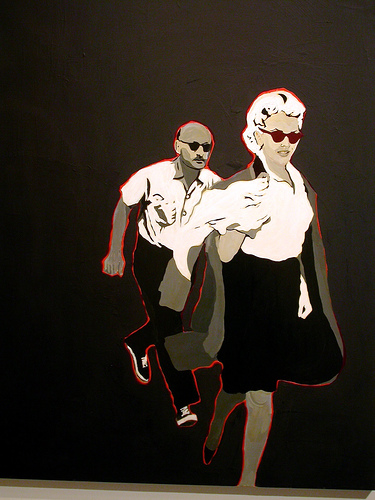
Marilyn Pursued by Death, 1967. Photo from the 2004 exhibit.
I spoke with the artist by phone recently and asked about paintings like Marilyn Pursued by Death (1967), an image that’s as good an icon of the movie star as you’ll find anywhere. Drexler–who’s also written several novels and won four Obies and an Emmy Award (for a Lily Tomlin special)–explained that when her gallery, Reuben Gallery, closed after only one or two seasons around 1960, the other artists got picked up by other galleries. But she didn’t.
“Women were not bankable at that time … I received no offers,” she says. Being married with a young child may also have worked against her.
“A lot of the men were very political and were aware of how to promote themselves. I, on the other hand … had no clue as to a career. What can I say? It’s different now, thank God. Women know how to promote themselves.”
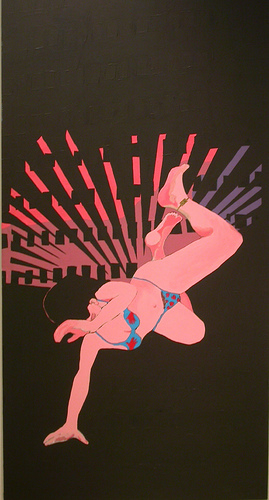
Ana Falling
It’s possible that Drexler’s edgy work with its emphasis on death (a boxer killed in a prize fight; Ana Mendieta falling to her death; a group of white men accused of a race murder) was a hard sell. Most pop was cool (think Katz or Lichtenstein). Even Warhol had lighter works that made it into the mainstream (soup cans, Brillo boxes). His death-soaked electric chair and car crash scenes are far less known and exhibited.
But Drexler is a groundbreaking artist. Her technique alone qualifies her for the history books. She was the first to embed images based on newspaper photographs in her canvases.
“Nobody else was doing this,” she says. “Tom Hess, a critic at the time … wrote I was the first person to use photos–to cut them and put them on canvas.”
She was also the first to paint sequential images from television, as she did in her six-screen sequence Death of Benny “Kid” Paret (1963).
Asked about her technique, she says, “I was hiding the image and giving it another face, like bringing the dead back to life in a strange way. I was very guilty about it–achieving something not out of your head. Little did I know [this technique] would become so hot.”
In his essay in the show’s brochure, Robert Storr compares Drexler to artist Raymond Pettibon‘s “brooding, maverick sensibilities.” Like Pettibon’s, Drexler’s works convey angst about the world that’s as relevant today as it was 40 years ago.
Drexler is in collections at the Whitney and the Hirshhorn museums, but I had never heard of her. It’s thanks to curator Sid Sachs that this important and reverberant work has been brought to light.



